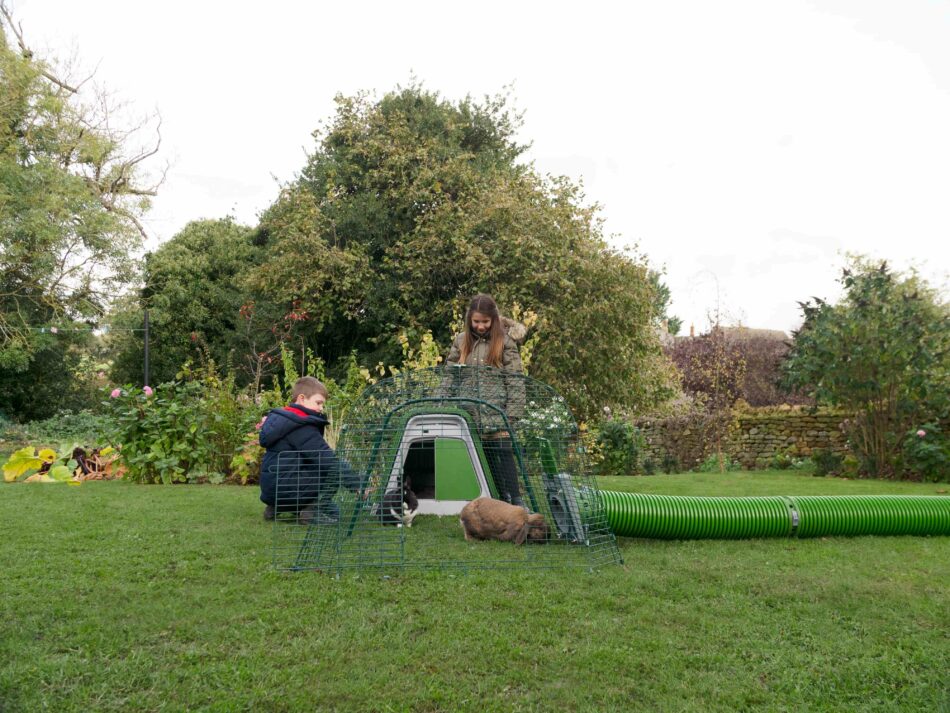 We often get questions about whether rabbits will be okay outside in the winter. The simple answer is: yes. But things get a little more complicated when you consider the specific climate, individual rabbits, and their setups. We’ll share how you can safely keep your outdoor rabbits outside during the winter, and how to determine if and when it’s time to bring them inside.
We often get questions about whether rabbits will be okay outside in the winter. The simple answer is: yes. But things get a little more complicated when you consider the specific climate, individual rabbits, and their setups. We’ll share how you can safely keep your outdoor rabbits outside during the winter, and how to determine if and when it’s time to bring them inside.
Can rabbits live outside during the winter months?
Rabbits that are accustomed to living outdoors are well-equipped to handle the winter months. At this point in the year, you’ve probably noticed your outdoor rabbits’ fur looking mottled due to a process called moulting. Moulting in rabbits is a natural process that prepares their coats for the winter months ahead, and is triggered by the amount of daylight. So, if your rabbit is outdoors during summer and fall, the dwindling daylight hours signal them to start shedding their thinner summer coat in order to regrow a more dense coat for the winter.
Once they’ve donned their winter coats, your rabbits can withstand the colder outdoor temperatures quite well. In fact, rabbits are much more comfortable in the cold than they are in the heat. But, in order for their natural insulating layers to be effective, bunnies need dry, clean areas to shelter in.
In the wild, rabbits will warm up in underground warrens, or burrows, and huddle together for warmth. Domesticated rabbits need a similar environment – a draft-free, dry hutch to warm up in. The Eglu Go Rabbit Hutch was designed with this in mind. The twin-insulated walls offer protection from drafts while containing the natural body heat of your rabbits within. And, our hutch is designed to provide ample ventilation to prevent moisture buildup, which is especially important during the winter months.
But will they be happier inside?
It may be tempting to bring your outdoor rabbits inside for the winter, but the trouble with this is threefold:
- Bringing your bunnies inside for more than brief visits acclimates them to your home’s interior temperature. This makes it more difficult to move them back outside without shocking their system.
- The artificial lighting in your home will disrupt their biological clock, which may cause them to shed their winter coat too early.
- They will need indoor accommodations away from the hustle and bustle of your home activities. Rabbits may become stressed by stimuli such as televisions, radios, children playing, or other loud noises – especially around the holidays.
Rabbits that are well adjusted to their conditions and schedules outside will thrive much better staying in their home all year round – including during the winter. If your rabbits have lived outside for the rest of the year, save for a couple of caveats.
How cold is too cold for rabbits?
Rabbits don’t adhere to a particular rule when it comes to temperatures. What is true for most bunnies might not apply to others. Observe your bunnies as well as the weather in order to gauge how cold is too cold for your rabbits. If temperatures have been gradually declining over several weeks, your rabbits’ coats should be sufficient to keep them warm enough in even sub-zero temperatures. But, here is where the first caveat of bringing your bunnies inside comes in:
- If the temperatures have been mild for weeks, and your area experiences a sudden and brief cold snap, you may want to consider bringing your rabbit indoors.
This is because a rapid and temporary drop in temperature can be too much for a rabbit that hasn’t finished growing its winter coat. However, the addition of extreme temperature protection on your rabbits’ hutch is enough to bolster your bunnies through a quick cold spell. You can also move your rabbits to a sunnier area of your garden, or under the shelter of a garage or shed in the event of freezing precipitation.
The other caveat to leaving your bunnies outdoors is their health:
- Older rabbits, or those with health conditions that may affect their coats or metabolisms should spend seasons with extreme temperatures indoors.
They don’t have to miss out on all the fun though. Rabbit runs and playpens can be utilised both indoors and outdoors to create safe spaces. On mild winter days, your rabbits will appreciate a romp outside in the sunshine.
What can I do to help my rabbits in winter?
This advice applies if you keep rabbits in an outdoor rabbit hutch and run. If you’re moving your pets inside you won’t have to worry too much about protecting them from bad weather.
Regularly checking in on your rabbits is one of the best ways to ensure they’re in good health, and give you an idea of how well they’re handling the weather. But, there are some other ways you can help your rabbits through the winter.
Exercise
Exercise helps ramp up your rabbits’ metabolisms to help keep them warm during the winter. Make sure they have plenty of space and opportunity to stretch their legs and generate heat. Connecting their hutch to a Zippi Rabbit Playpen via our Zippi Rabbit Tunnel System gives them plenty of room to burrow, explore, and play.
Location
Keep your rabbits’ hutch in a place that receives as much sun during the day. Use clear rabbit run covers during the winter months to allow warming rays of sunshine in for your rabbits to stretch out. If your area receives a lot of snowfall, the addition of wheels and handles to your rabbit hutch allows for quick and easy movement to shelter or shovelled areas.
Bedding
You’ll find your rabbits spending more time in their hutch during the winter due to both decreased daylight hours and temperatures. Make sure to change their bedding frequently to keep them clean and dry. Choose a thick bedding like straw and provide a thick layer for your bunnies to burrow into.
Diet
Your rabbits should have unlimited access to timothy hay all year round, as well as a serving of quality pellets daily. To stoke their metabolisms during the winter, gradually add in alfalfa hay or pellets into their diet to provide extra energy. Other treats like leafy greens can be served in a Caddi Rabbit Treat Holder to keep it up off of the frozen ground.
You’ll also want to switch to a crock or bowl for their water during the winter months to prevent bottles from breaking in freezing temperatures. A bird bath heater or plug-in heated pet water bowl can be used to keep their water thawed – just be sure that the cords are not within your rabbits’ nibbling range.
Your outdoor rabbits with Omlet
Don’t stress over your rabbits during the colder weather. With our Eglu Go Rabbit Hutch, Zippi Rabbit Runs and Playpens, and Zippi Tunnel System, you can create a winter wonderland that both you and your rabbits can enjoy. With dry, insulated dwellings, your bunnies will boldly take on the chilly temperatures – and you will rest assured knowing they’re comfortable and happy not just during this season, but all year round.
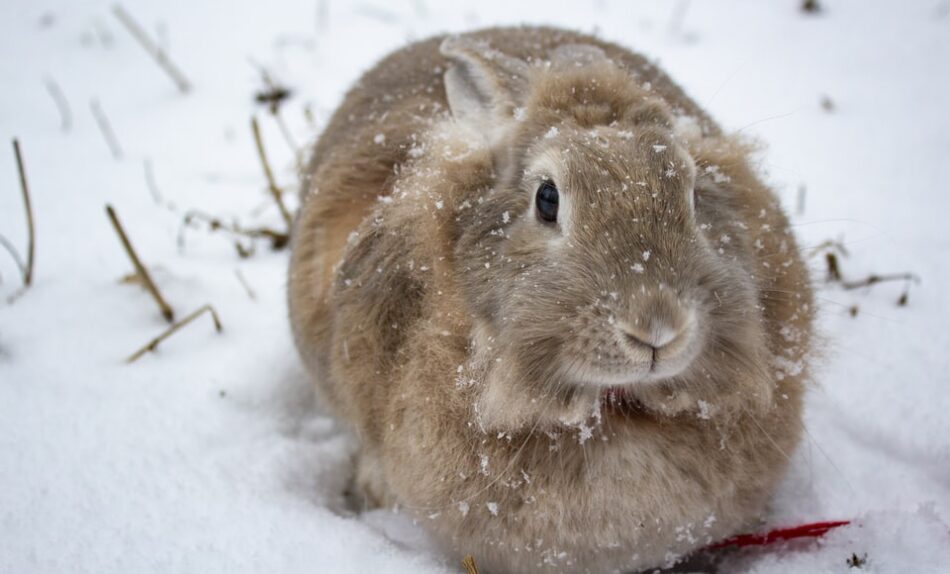
This entry was posted in Rabbits on October 30th, 2020 by linnearask
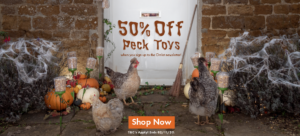
Trick or treat your hens this Halloween with a s-peck-tacularly spooky Peck Toy! Save 50% on Peck Toys when you sign up to the Omlet newsletter!
Terms and conditions
This promotion is only valid from 29/10/20 – midnight on 02/11/20. Once you have entered your email address on the website you will receive a discount code that can be used at checkout. By entering your email you agree to receive the Omlet Newsletter. You can unsubscribe at any point. This offer is available on single Poppy and Pendant Chicken Peck Toys only. The offer does not apply to Twin Packs or Twin Pack with Caddi Treat Holder. Offer is limited to 2 Peck Toys per household. Subject to availability. Omlet ltd. reserves the right to withdraw the offer at any point. Offer cannot be used on delivery, existing discounts or in conjunction with any other offer.
This entry was posted in Chickens on October 29th, 2020 by linnearask
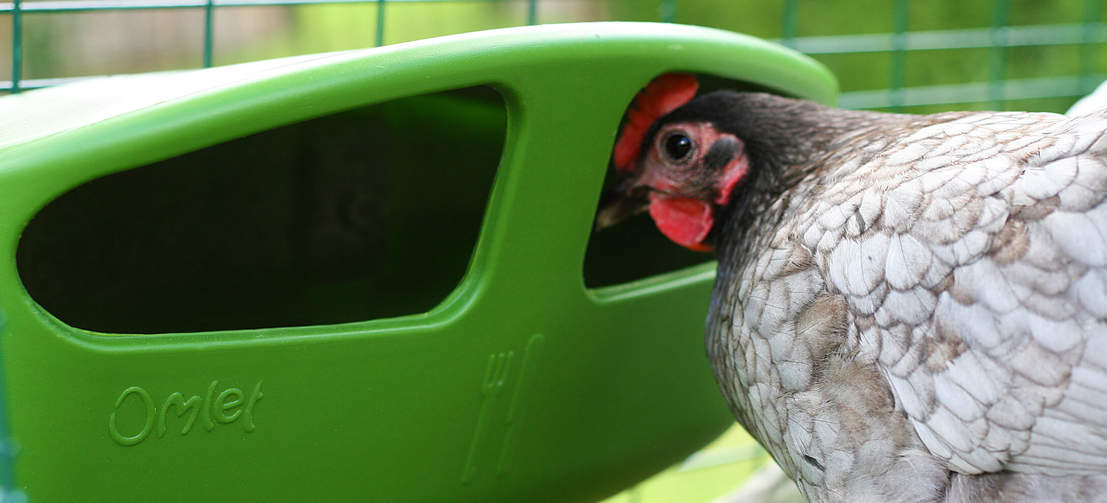
Chickens are great foragers, and free-range birds will peck and scratch for all kinds of wild treats, from grass and weeds to worms and beetles. However, even a hen with all-day access to a garden or meadow still needs to be fed with high-quality layers pellets. These contain the correct balance of protein, carbohydrate, vitamins and minerals (notably calcium for egg shells) that will keep them happy and healthy. Protein is particularly important for healthy egg production.
A general ballpark figure is very useful, to guarantee that the hens’ dietary requirements are being met. For medium-sized breeds such as the Rhode Island Red, Oxford Brown or Orpington, you need to feed between 115 and 120 grams (just over a quarter of a pound) of feed per chicken per day, which is 805 to 840 grams (one and a half pounds) of feed per chicken per week. A slightly larger Sussex will eat a bit more, and the smaller Leghorn will eat slightly less, while a small bantam breed will only eat between a half and three quarters of that amount.
Chicks, Pullets and Layers
Until it is five weeks old, a chick will need to have its diet supplemented with protein-rich ‘chick crumbs’. Between then and 18 weeks old, while they are ‘pullets’, the birds will need ‘growers pellets’ to put on weight. As soon as the hens begin laying, they only need the regular ‘layers pellets’. These, again, are rich in protein, calcium and all the other essential nutrients.
The hens will also need daily access to grit. Treats are fine, as long as they are not being offered so frequently that the hens fail to eat their share of pellets. Corn is a healthy treat, and birds that have free-range access to grass will be in chicken heaven.
How Can You Make Sure Each Hen is Getting Her Share of the Food?
Any flock of chickens develops a natural pecking order, and the dominant birds will tend to eat their fill before the others, if there is not enough space for all the hens to fill their crops at once (something they like doing shortly before retiring for the night). A solution here is to buy a wide-bottomed feeder that allows several birds to eat at once, or to use more than one feeder. This will ensure the timid hens get their fair share of food.
However, as long as you have provided enough for all your hens, there should always be food left in the feeder when the dominant birds have had their fill. You should still keep a close eye on the health of your flock, though. Issues such as soft shells or feather-plucking can be signs of dietary deficiencies, and the problem might lie in the quality rather than the quantity of the birds’ diet.
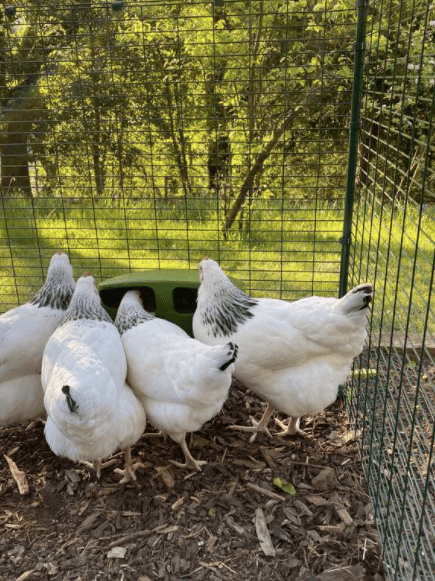
Do Hens Eat the Same Food All Year Round?
Chickens moult every year, and will usually eat more food during this process, to ensure their bodies have all the protein they need to grow a new set of feathers. Hens usually eat more during cold weather, too, in order to fuel their metabolisms and stay warm. Free-range hens also tend not to find as many treats in the garden during the winter, as the insect population is at low ebb and the grass is no longer growing.
You can add a little more food each day during these periods. You will soon know if you are giving them too much or too little, by noting the amount of pellets left in the feeder each evening.
However, the hens produce fewer eggs in the winter, so all in all the amount of protein-rich pellets required does not differ significantly from season to season. Again, the key detail is to ensure a regular supply of food. In the summer, if your hens appear to be eating very little, it may be because they are finding too many good things on their foraging trips in the garden. This can be a problem if the wild food they are filling up on doesn’t provide the right balance of nutrients. You might want to confine a hen to the coop if she doesn’t seem to eat enough pellets. That way, she will be forced to eat the good stuff rather than the garden treats.
Layers pellets should be available to your hens throughout the day – they will eat as much as they need, and will not behave like a dog, eating everything at once simply because it’s there!
This entry was posted in Chickens on October 23rd, 2020 by linnearask
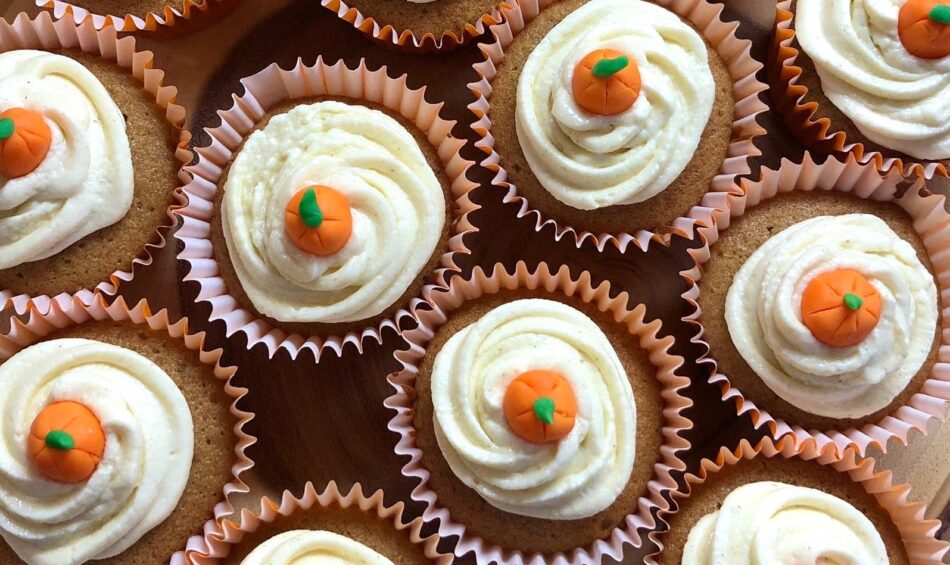
Not a fan of Pumpkin Spice? Fancy trying something simple, yet seasonal you can make with your girls’ eggs? Try out these delicious ginger cupcakes, with a nod to autumn on top!
To make 12 delicious ginger cupcakes, you will need…
- 12 cupcake cases (we’ve gone for orange to stay on theme!)
- 150g margarine or unsalted butter (softened)
- 150g light muscovado sugar
- 150g self raising flour
- 1 – 2 tsp ground ginger (to suit your taste)
- 2 large eggs
- 1 tbsp golden syrup
For the buttercream, you will need…
- 250g margarine of unsalted butter (softened)
- 500g icing sugar
- ½ – 1 tsp ground ginger (to your taste)
For the pumpkin decoration, you will need…
- Ready to roll fondant icing sugarpaste – orange
- Ready to roll fondant icing sugarpaste – green
- Preheat the oven to gas mark 4 (fan 160), and line a muffin tin with 12 cupcake cases.
- To make your ginger cake mix, start by creaming together the butter and sugar in a mixing bowl. Sieve the self raising flour into the mixture with the ginger. We used 2 tsp of ground ginger but you can use less if you prefer a more subtle taste.
- Lightly whisk the eggs in a bowl and add them to the mixture. Mix everything together carefully.
- Once mixed add the golden syrup and give a final stir.
- Fill the 12 cupcake cases with the ginger cake mixture as evenly as possible.
- Place in the oven for 15 – 20 minutes.
- Leave to cool on a cooling rack before making the buttercream icing.
- For the buttercream icing, add a small amount of icing sugar to the butter at a time and cream together. Once smooth, add up to a tsp of ground ginger to the icing.
- Put the icing in a piping bag. We used a large, star shape nozzle for the piping. Start in the middle and circle round leaving some space at the edge of the cake. Then spiral up on top and pull away to leave a peak.
- Once you have iced all 12 cupcakes, you can decorate however you wish! We decided to make little pumpkins out of ready to roll icing. Simply roll the orange icing into small balls, no more than a cm in diameter. Then use a sharp knife to carefully draw lines down the pumpkin.
- Roll a small amount of green icing a long strip then cut into tiny pieces to create the stalks. Press the stalk down lightly onto the pumpkin, and place on top of your cakes.
This entry was posted in Recipes on October 21st, 2020 by linnearask

Chickens really are wonderful pets for the whole family. Aside from providing delicious daily eggs, they’re super fun to watch, hang out with, and can teach children valuable life lessons. Compared to other pets, chickens are also relatively low maintenance, and caring for them doesn’t really require much that children from primary school age won’t be able to at least take part in. Read on to find out more reasons why chickens are great pets for families with children.
Responsibility
Having chickens will help children of all ages learn about taking responsibility for another living being. Whilst they should never be given full responsibility for all the chook care duties, even allowing them to scatter some corn for their feathered friends or refilling the drinker can help children build a wondrous connection and gain a better understanding of what it means to take care of another.
Routines
Chickens are pets of routine and part of your daily regime as a keeper includes, but is not limited to, cleaning out the coop and run, filling their feed and waterers and collecting eggs. Having pets that need structure helps children to understand the importance of a routine, which, is something many kids can thrive with,
Food
Keeping chickens will teach your children that food does not magically appear on supermarket shelves. If they care for their own chickens, they’ll hopefully realize how important it is for animals to have enough space and adequate care, and they will not take animal products for granted.
Chickens and children: things to consider
Dream big, start small
Whilst you might be tempted to start off with more, begin with a smaller flock of no more than 5 chickens. That way, your children will easily be able to differentiate them and give them names based on their personalities. Too many at once makes the chickens seem like a flock rather than a group of individuals. And at a later date, there’s nothing stopping you from falling victim to the infamous “chicken math” when your children are older!
Happy hens
Stick to hens. It’s probably a good idea not to get a rooster to start with. Whilst some chicken keepers have their own personal reasons as to why they want to keep cockerels, they’re not for everyone. For one, they’re much more confident and pushy than hens and can be a bit intimidating for younger children.
Easy peasy coop cleaning
Get a coop that makes chicken keeping easy, so that the kids can help. The Eglu Cube chicken coop is perfect for adults and children alike. With the innovative design, even younger members of the family can even help with the cleaning of the coop. Simply empty the dropping tray and wipe down the smooth surfaces of the house once a week, and your coop will look shiny and new every time.
It’s super easy to let the chickens out in the morning and close the coop at night too with the optional Autodoor. Plus, collecting fresh eggs is a breeze with the egg port found on the side of the coop.
Start them young
Even if you’re not incubating eggs and rearing chicks yourself, getting young chickens is a good idea if you want your children to be involved. Encourage regular interaction, and try to pick up the chickens regularly to get them used to being handled. This is sometimes made easier by having the chickens in a run that is easy to access, like the Walk In Run.
Which breed?
There are a number of chicken breeds to choose from, all of which with their own pros. When choosing chickens as family pets though, opt for a friendly and hardy breed that’s renowned for getting on well with kids. Silkies, for example, are famous for being loving and happy to be held, Orpingtons are calm and affectionate and Cochins easily adapt to any situation they are confronted with.
Omlet and your family pet
Whether you’re a first-time chicken keeper looking for a new family pet or expert, Omlet has everything you need to give your chooks the best lives possible. From our range of easy-to-clean chicken coops, to our Autodoor to take the guesswork out of bantam bedtime, chicken keeping has never been more simple or fun than with Omlet.

This entry was posted in Chickens on October 20th, 2020 by linnearask
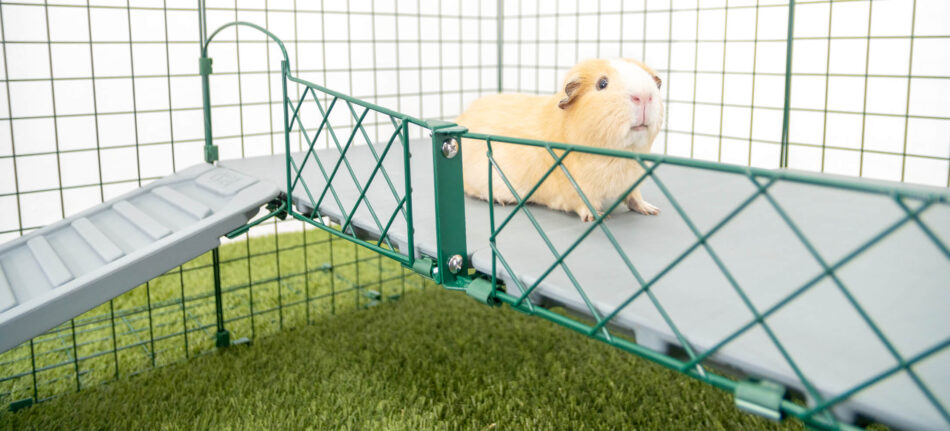
Guinea pigs, AKA Cavia porcellus originate from the South American Andes, where they lived amongst the varying terrains of the mountains. Foraging comes naturally to this species as their ancestors spent their days exploring the rocky landscapes and grasslands to find their next source of food. And whilst these pets are not built for marathons, what they do need is a combination of hutch and run along with extra tunnels and accessories to provide them with plenty of exercise space and mental stimulation. Omlet’s guinea pig products have been expertly designed to encourage this instinct, ensuring that today’s household cavies get the exercise they need.
How do guinea pigs exercise?
Whilst small mammals of the rodent families may all look adorable, fluffy and vaguely similar, hamsters and guinea pigs do not have the same needs. Therefore, hamster-style wheels and balls are not required (and can, in fact, be very dangerous for guinea pigs). You can discover more about this topic in our What’s The Difference Between a Hamster and a Guinea Pig? blog. Instead, you should make sure that the floor area of your guinea pigs’ hutch is a minimum of 0.75 square metres for hutches containing two cavies.
The floor area is where they’ll spend much of their time, so the bigger the living quarters, the better. The indoor part of a hutch is only half the story, though, and guinea pigs need some outdoor space, too. It is recommended that they should have at least three hours each day exploring, filled with plenty of exciting exercise, where they can run, skip, and popcorn! This is easy to arrange if you combine a hutch and run, and an all-in-one living space such as The Eglu Go Hutch for Guinea Pigs is the ideal option.
Guinea pig runs can also be linked to outdoor playpens using an arrangement such as the Zippi Guinea Pig Tunnel System. Whilst guinea pigs no longer have to search amongst the terrains of the Andes for food, this kind of flexible system allows you to construct anything from a simple A to B tunnel, to a full-blown maze with a delicious vegetable hunt, allowing them to practise this behaviour. Did you know that a guinea pig’s sense of smell is actually 25x better than humans?! Therefore, a tasty vegetable hunt using your Zippi Tunnel System, Zippi Shelter, and Guinea Pig Tunnels, is the perfect setup for physically and mentally stimulating your cavies!
For a pair of Guinea pigs, a one- to two-metre-square run provides ample space. If you can to give the pets more space than this, they will only really use it fully if it has plenty of tunnels and bolt holes to head for – guinea pigs don’t like to be too far away from somewhere safe and cosy, and will not usually roam in a large garden.
How do you exercise a guinea pig? – encouraging your cavy
Guinea pigs are more inclined to run around and have fun if they have companions to play with. So, rule number one for ensuring that your pets get enough exercise is to provide them with at least one playmate. In the wild, extended family groups could be at least10, but you should always keep the numbers to a level dictated by the size of the hutch and run. You need to get the mix right, as a male and a female will inevitably mate, which has obvious consequences in terms of space and mouths to feed.
Groups of males or groups of females are the best option. A castrated male will mix very happily and placidly with females, and any small disagreement and scuffles among your guinea pigs is unlikely to result in injury and is all part of their exercise routine.
Incorporating hiding places in your run/hutch/tunnel set up is an important detail. Guinea pigs instinctively have one eye on a safe bolt-hole when they are out and about, and scurrying back to safety is probably their most strenuous form of exercise.
You can encourage your pets to scout around and stretch their legs by putting interesting objects in their run, such as a Caddi Treat Holder, wicker toys stuffed with guinea pig treats, chews, tunnels and simple hideaways in the form of terracotta caves and igloos. They will also play happily with the cardboard tubes from the inside of loo-rolls and paper towels, or a simple cardboard box, especially if these items are stuffed with hay and fresh veggie treats.
One of the things that gives guinea pigs such a unique character is their loveable combination of endless inquisitiveness and nervousness. They follow their noses, explore everything, and then dash back to safety, making those wonderful wheep wheep sounds as they do so. With this mixture of playing and bolting, their exercise needs are easily met – all you need to do is provide the hardware.
Guinea pig exercise is all about exploring and interacting. They are very sociable animals, moving around their enclosure in groups or dashing away on little adventures of their own. You can find everything you need for your fluffy friends on the Omlet Guinea Pig shop and for even more ideas on guinea pig exercise why not take a read of our Guinea Pig Activities blog?
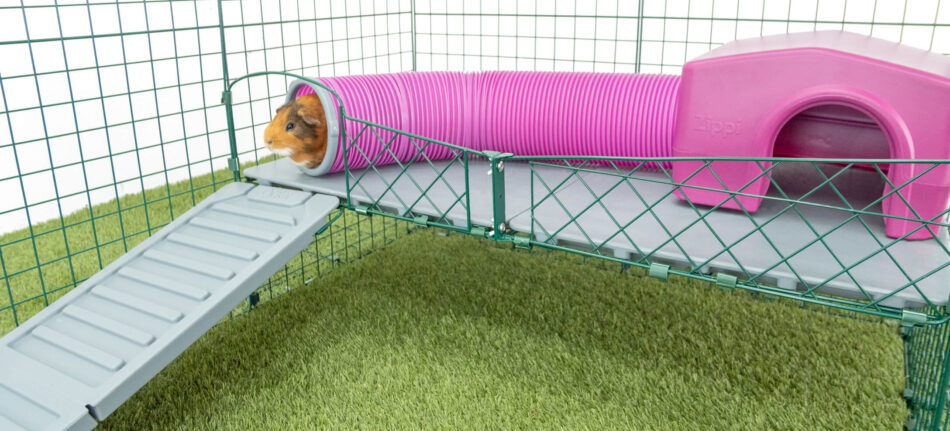
This entry was posted in Guinea Pigs on October 16th, 2020 by linnearask
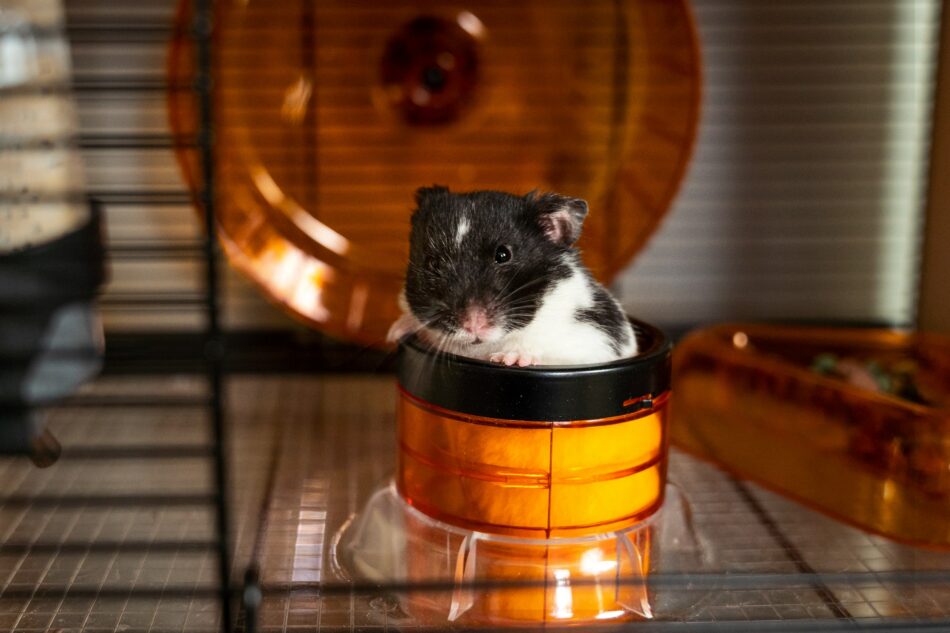
If you’ve recently added a hamster to your family, or are considering getting one, you may be wondering what illnesses hamsters get, and how they can be treated. Thankfully, since hamsters are active pets with hearty appetites, it’s usually apparent when they aren’t feeling their best. We’ve outlined some of the most common ailments that hamsters may experience, and what to do if you notice anything amiss with your small mammal friend.
How healthy are hamsters?
Hamsters are generally healthy animals that live full, but relatively short lives. Depending on the breed of hamster you have, the life expectancy for even healthy hamsters is between 2-4 years. But, over the course of your time together, you may see your hamster acting “off” or even display obvious signs of illness. It’s important to perform regular health checks on your hamster to identify any potential problems early on.
By checking in with your hamster daily, you’ll be able to see if there are any issues with their coat, teeth, eyes, or paws, and note any behavioural changes. It’s a good idea to get your hamster established with a veterinarian that treats hamsters as soon as you get them – that way both you and your veterinarian will have a baseline for your hamster’s health. And, if you notice anything wrong with your hamster, a quick phone call or visit with the vet will help put your mind at ease.
Most common illnesses in hamsters
This is not an exhaustive list, but the following illnesses and ailments are those that hamsters are most commonly seen with. By recognizing the signs and symptoms of each, you’ll be able to determine the best course of action.
Abscess
Hamsters can develop infections if they have cut or poked themselves, which can allow abscesses to form. Hamsters that chew on the bars of their cage may develop an abscess in the mouth, or you may see an abscess on the sides or legs of hamsters that have cage mates from rough play or fighting.
Note: Abscesses need to be treated by a vet – do not attempt to drain an abscess at home.
Colds
Your hamster can actually catch a cold from you. The same virus that causes the common cold in humans can be transmitted to hamsters. Signs and symptoms of a cold in hamsters are similar to those in humans:
- Watery eyes
- Discharge from the nose
- Coughing
- Wheezing
- Sneezing
- Lethargy
Your hamster’s coat may also appear to stay wet as they continually wipe their runny nose on their fur.
Treatment for a cold in hamsters includes:
- Keeping their bedding fresh, taking care to use a dust-free variety
- Offer plenty of food and water
- Supplement their food with cod liver oil
Colds will usually pass quickly and on their own, but if your hamster stops eating or drinking, it may be time for a trip to the vet to rule out secondary infection. Try to avoid handling your hamster when you have a cold to prevent passing it along to them.
Cuts
Skin abrasions are more common in hamsters that live together. Scuffles, rough play, or challenges to the hierarchy can result in cuts. If you don’t have a safe and secure hamster cage, you may see a hamster with cuts even if they live alone. These are usually from weak or bent cage wires, ill-fitted tubing, or sharp plastic edges.
Cuts can usually be cleaned at home with warm soapy water. However, hamsters will lick and tend to their wounds, so anything more than a superficial wound may not heal well without antibiotics or other treatment from the vet.
Problems with the ears
A hamster that scratches at their ears constantly, seems sensitive around their head when being held, or appears off-balance or walking in tight circles, an inner-ear infection may be to blame. Your veterinarian can prescribe antibiotics or anti-inflammatories to treat ear infections. While seeing your hamster in distress may be upsetting, ear infections usually clear up quickly.
Dry ears are another common problem. Along with incessantly scratching at their ears, you may also notice the skin around your hamster’s ears cracking or flaking. To remedy this, rub some vaseline on their ears with a cotton swab for a few days.
Problems with the eyes
Any swelling in or around your hamster’s eyes, discolouration of the eye itself, or thick or coloured discharge is not normal, and warrants a call to the vet. Some possible causes include:
- Trauma to the eye (a puncture or scratch)
- Foreign object in the eye
- Trouble with their cheek pouch
- Oral abscess
- Allergic reactions
- Tumors
- Glaucoma
If your hamster’s eye is so goopy that it is matted shut, apply a warm compress (water on a soft rag) for a few minutes to gently remove the crusted material. Don’t try to force your hamster’s eye open once the material is removed – they should be able to open their eyes on their own after a few minutes of having them cleaned.
Lumps
Being familiar with normal hamster anatomy will help you determine if something isn’t right. Some lumps and bumps are normal (especially in males or lactating females), but you’ll know quickly while handling your hamster if something has popped up suddenly.
Lumps don’t all have scary causes, but you should always have them checked out by a veterinarian. They’ll likely take a small sample with a tiny needle to determine the makeup of the lump. Some potential causes are:
- Lipomas (benign, fatty tumors)
- Cysts
- Abscesses
- Enlarged glands
- Tumors
Mange
The parasites that cause mange can’t be seen with the naked eye – but they do cause obvious discomfort in your hamster. Symptoms of mange in hamsters include:
- Scratching at their bodies excessively
- Hair loss
- Red or scaly patches of skin
- Matted hair coat
The mites that cause mange can be seen under a microscope, so your vet will likely take a small sample of the inflamed skin of your hamster. If your hamster is diagnosed with mange, they will need baths with a special shampoo that your vet will prescribe.
Fleas or lice
These parasites can infect your hamster if other pets in your household have them. It’s important to keep your dogs and cats on a flea preventative to avoid your small pets from getting them. The same preventatives are not safe for hamsters, so be sure not to apply any flea products on your hamster without direction from your veterinarian.
If your hamster has many visible parasites, you can bathe them in warm water with a small amount of unscented dish soap (be sure to dry them thoroughly so they don’t get chilled). The lather from the soap will kill the existing parasites – but won’t prevent more from hitching a ride on them later. Treat all the animals in your home for fleas and lice to prevent re-infestation.
Strokes
Due to their short lifespans, hamsters age rapidly – and sometimes all of a sudden. Part of this ageing process may include strokes. Symptoms of a stroke include:
- Unsteady gait
- Circling
- Swaying or other involuntary, repetitive motion
Most strokes are small enough to not leave your hamster significantly impaired. But, no matter the size, there is no treatment or prevention for strokes in hamsters. If your hamster has suffered a stroke, they may need to have their housing adjusted to make them more comfortable. Keeping their food bowl topped off and waterer full will help them stay nourished, and you may need to remove obstacles like their wheel or tubing to prevent injury.
Issues in the mouth
A hamster with a poor appetite is surely feeling under the weather. But, sometimes the cause of a poor appetite is actually inside of their mouth. Hamsters are rodents, and as such, their teeth grow constantly. They need to be able to gnaw on applewood toys and be fed a quality pellet as the main staple of their diet to keep their teeth filed down. Reasons other than overgrown teeth that may cause oral discomfort in hamsters include:
- Infected cheek pouches
- Loose or infected teeth
- Oral abscesses `
- Injury to the mouth or jaw
If your hamster seems reluctant to eat, but appears and acts fine otherwise, they’ll need to be seen by your veterinarian.
Urinary problems
If you spot blood on your hamster’s bedding, it could be due to an injury, a burst abscess, or a urinary infection. An examination of the hamster’s bedding will tell you if it is the latter problem. A change in urine colour, or a lack of urine, indicate health issues too.
Keeping your hamster’s cage clean is good practice for their overall health, but their bedding can tell you a lot about their health. The colour, odour, consistency and amount of urine in their cage can point to potential issues with their urinary tract. Signs of a hamster experiencing urinary tract issues include:
- Blood in the urine
- Thick, cloudy urine
- Decrease in urine output
- Urine with a foul odour
Urinary tract infections can turn serious quickly, so it’s best to have your hamster evaluated by a veterinarian if you notice a change in their eliminations.
Wet tail
“Wet tail” is a term for serious, bacterial diarrhoea that causes faeces-soaked fur around the tail. This condition can prove fatal quickly for hamsters – not only from the bacterial infection, but from dehydration.
Offer plenty of water until you can get your hamster to the veterinarian. Wet tail should not be treated at home, as time is of the essence to save your hamster from this illness.
Preventing illness in your hamster
The absolute best way to treat illnesses in your hamster is to try to prevent them entirely. Housing your hamster in a cage like the Qute Hamster Cage by Omlet will make cleaning quick and easy – keeping your hamster clean and healthy. The removable bedding tray makes complete bedding changes a breeze, and the wipe-clean plastic surfaces don’t give bacteria a chance to set up shop.
If you have a social hamster breed, be sure to quarantine new hamsters for a minimum of two weeks before introducing them to your other hamsters. Feed all of your hamsters high-quality feed and offer fresh water daily to keep their immune systems and digestion working properly.
Omlet and your hamster’s health
Our Qute Hamster Cage was designed with both humans and hamsters in mind. Our all-in-one hamster home gives your furry friend everything they need to thrive, and cuts down on your time spent cleaning so that you can get back to bonding with your hamster. And, even if your hamster does become ill, the Qute will keep them comfortable while they’re under the weather, and help you keep their home clean with minimal effort – giving you more time to show them the extra love and care they need.
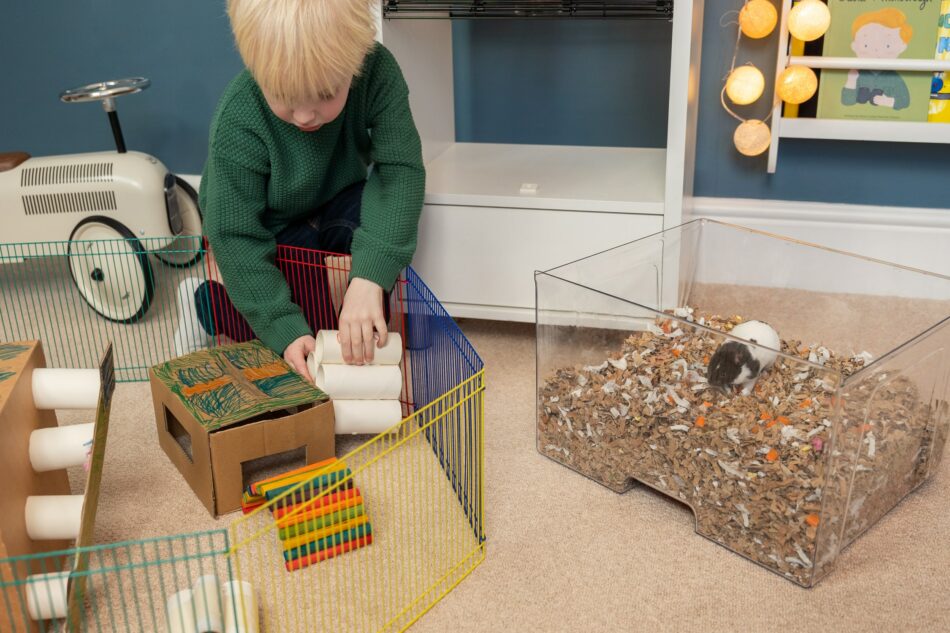
This entry was posted in Hamsters on October 15th, 2020 by linnearask
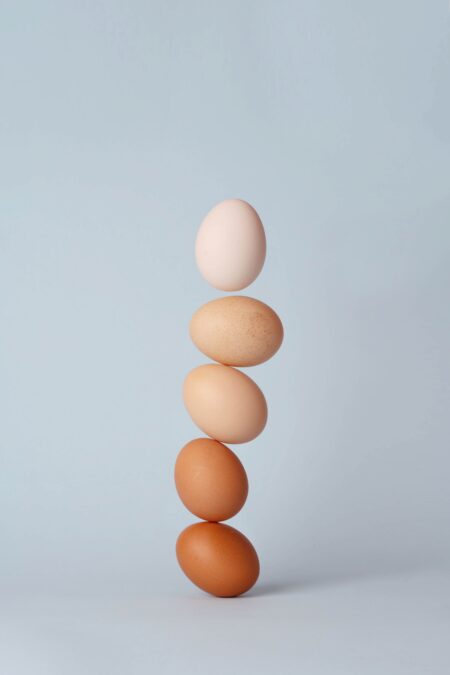 Most people would agree that the yolk is the best part of the egg. A double-yolker in the breakfast pan is therefore a very welcome sight!
Most people would agree that the yolk is the best part of the egg. A double-yolker in the breakfast pan is therefore a very welcome sight!
Some hens lay double-yolkers every time, a genetic quirk that simply means two yolks are released into the system instead of one. However, hens that manage this impressive feat are rare, and no single breed has been developed to pull off the double-yolk trick every time.
The one-egg-with-two-yolks breakfast can still be yours every day, though, if you’re willing to pay extra for it. You may have spotted double-yolk ‘super eggs’ on the shelves of certain supermarkets – sold at a premium, of course – but these are nearly all from young birds, rather than the mythical Double Yolker breed. It’s worth pointing this out, as a Google search will lead to some interesting information about such a breed. But it doesn’t exist – yet!
Most double-yolk eggs encountered by chicken keepers come from young hens. Point-of-lay birds tend to produce a very small egg or two, and then a couple of double-yolkers, before their bodies settle down into a regular four or five eggs-per-week pattern. A double-yolk egg after this early laying stage is very rare in most birds, although some hens begin to produce double-yolkers again towards the end of their egg-laying lives. Circumstantial evidence suggests that the Rhode Island Red, Oxford Brown, Sussex, and Leghorn breeds have a higher chance of producing double-yolkers.
How Are Double Yolks Formed?
Hens’ bodies release a yolk approximately two hours after the previous egg has been laid. Once in the hen’s oviduct – the part of the bird’s body in which the eggs are formed – the yolk is surrounded by the white albumen part of the egg and then covered in hard calcium. If a hen has released two yolks side-by-side, the egg-forming process treats them in the same way as a single yolk, resulting in two yolks ‘trapped’ inside a single egg shell.
If double-yolked eggs are fertilised, the result is two chicken embryos in one shell. Most of these ‘twin’ eggs fail to develop properly, though, with only one chick growing beyond the early development stage, or with neither of them developing. This makes it rare for two chicks to emerge from one egg. Chicken breeders are advised to put aside the double-yolkers to prevent them developing, and in commercial operations most double-yolkers are sold to food companies that use eggs in their products.
How Can You Tell If An Egg Has Two Yolks?
You don’t need to crack the shell to find out what’s inside – you can spot a double-yolker by ‘candling’ the egg. The word candling comes from the ancient practice of holding an egg in front of a candle flame, but a small torch does the job just as well (although they are still ‘candled’ rather than ‘torched’!) If there are two yolks inside, they will be visible as two dark blobs against the bright light as it shines through the shell.
So, although double-yolkers are estimated to occur in just one per thousand eggs, the sheer abundance of point-of-lay hens means that they are a common sight on the plates of chicken keepers around the world.
Triple yolkers, however, are very unlikely to grace the breakfast table. This super-rarity is found in just one egg per 25 million!
This entry was posted in Chickens on October 12th, 2020 by linnearask

As the dark nights creep in and hours of sunlight diminish by the day, we know that winter is approaching. But for all the fun festivities that the season brings, some find their sense of well-being suffers. This is known as, Seasonal Affective Disorder (SAD). We know how less daylight can impact our lives, but what about our four-legged friends? Can dogs get Seasonal Affective Disorder too?
What is Seasonal Affective Disorder?
Seasonal affective disorder, also fittingly known as SAD or winter depression, affects between 0.5 and 3% of the population annually* during fall and winter.
Research continues to be done as to why this happens, but from what scientists do understand, the condition is linked to shorter days and therefore, less sunlight. A lack of sunlight can then affect the part of the brain called the hypothalamus. This can lead to decreased production of the hormones melatonin, which regulates sleep, and serotonin, responsible for a large part in controlling our mood and appetite. It is also likely that our bodies’ internal clocks are disturbed by the lower light levels, causing further symptoms of SAD, such as oversleeping, weight gain and social withdrawal.
Do dogs get SAD?
There is no official diagnosis of SAD in dogs, but recent studies** have suggested that seasons can negatively affect animals as well. Surveys also show that many dog owners notice that their dogs seem down and less enthusiastic during the winter months. Due to this, awareness of SAD in dogs is growing.
SAD in dogs – what are the signs?
Symptoms of SAD in dogs include a persistent low mood, loss of interest in otherwise fun activities, increased appetite, and the need for more sleep than normal – very similar to how humans experience SAD. You should also watch out for out-of-character canine toilet accidents and hair loss, as these can be symptoms too.
Beating canine SAD
When it comes to SAD, there’s definitely a light at the end of the tunnel. And, by following the below, your furry friend can be on their way to enjoying everything the new season brings and beating the blues.
Keep Fido fit
Keeping your dog fit and active is one way to lift their mood. While it can be tempting to avoid the outdoors when it’s muddy and rainy, it’s important to keep up with their normal active routine throughout the colder months. Continue to meet up on pup playdates and make an effort to ensure dog walks remain exciting by practising some new tricks, changing the pace, or trying out a new location. Even better, if your work schedule allows it, walk your dog while the sun is still up, so you’re both soaking up some natural light.
Light up their life
Humans with SAD can sometimes benefit from artificial sunlight lamps, specially designed to mimic sunlight. There is currently no evidence a SAD light will help boost your dog’s serotonin, but contact your vet to find out if this could be an option. Plus, if it helps to make you feel better, your dog will pick up on your uplifted mood and in turn, they’re less likely to suffer, being so in touch with their owner’s emotions.
Natural sunlight is more likely to help your dog though, so when Fido is at home, keep the blinds and curtains open during the daytime to let in as much light as possible.
A little reshuffle
Where you place your dog’s bed and crate is an important decision. After all, our four-legged friends average anywhere between 12 and 14 hours of sleep every day. A dog bed and dog crate should be placed in a cosy spot, free from drafts and disturbances but, when fall comes around, a little reshuffling can go a long way. If their bed is hidden away in a dark corner and far away from a window, you should consider moving it somewhere closer to a spot where natural light comes in.
What next?
Any sudden change in your dog’s behaviour can be a cause for concern. While SAD isn’t uncommon in pets, you should first question whether there have been any other major changes in your or your dog’s lives. Perhaps you’ve moved home recently, or maybe you’ve got a new job so haven’t been able to spend as much time with them. Once these are ruled out, a trip to the vet will also be able to rule out any physical illness or injury.
Should your vet diagnose your pup with SAD, they’ll likely suggest new ways to keep your dog stimulated or offer a supplement to give them.
Omlet and your dog
Omlet dog products have been designed for all seasons. From cosy dog beds and luxury dog blankets to dog cooling mats and dog toys, Omlet products are engineered to make sure you and your dog are happy together, whatever the weather.

*Seasonal affective disorder: MedlinePlus Genetics
**Seasonal Affective Disorder (SAD) in Pets | Can Pets Suffer From Seasonal Affective Disorder? | PetMD
This entry was posted in Dogs on October 9th, 2020 by linnearask
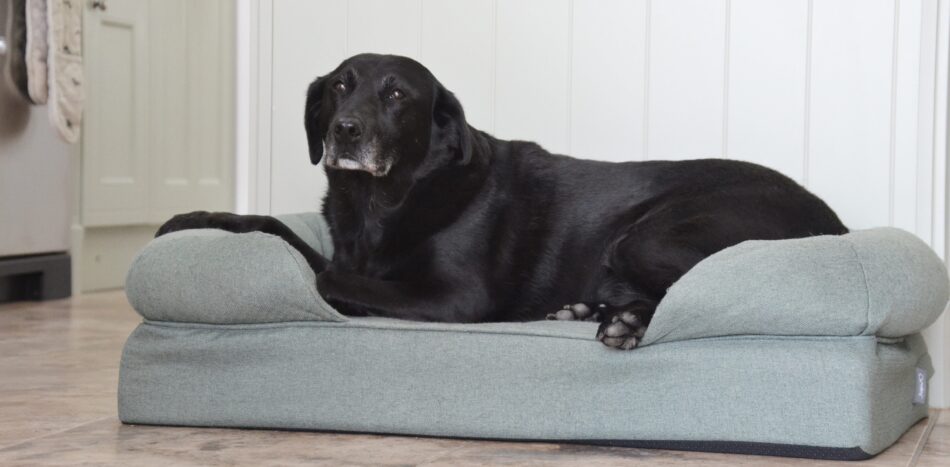
Dogtor™ Adem, Dog behaviourist & trainer, discusses everything you need to know about dog beds, which types may suit which breed and age of dog, and why we might see our four-legged best friends exhibit certain behaviours in and around their beds. Read on to learn more!
What should I look for in a dog bed?
A dog bed should be comfortable for the breed type, age and size of your dog. If you have an older dog, they might benefit from an orthopaedic or memory foam bed, such as the Omlet Bolster Bed with premium memory foam mattress, which gives support by gently moulding around your dog. A puppy, on the other hand, might benefit from a bed that can absorb water if, for example, a bowl of water is accidentally knocked over by them or they ‘toilet’ on their bed area whilst still being house trained. For puppies, you may also want to consider a type of bedding that is comfortable for them but not too precious or expensive due to the higher risk of this bedding being chewed or damaged as they play and explore. For me, it is also important to choose a bed that is robust and can be easily washed. Again the Omlet Bolster bed is a great choice with this feature! This not only helps the environment by limiting the need to frequently replace a smelly or very worn dog bed with a new version, but also ensures any accidents or dirt brought into their dog bed area can be easily cleaned away, keeping their bed area hygienic and inviting. You could also consider covering your dog’s bed with a removable and washable cover, particularly in the winter months.
What type of bed might suit my breed of dog?
Certain breeds might need more cushioning than others to stay comfortable and limit their potential for developing sores or sore patches, for example greyhounds who are considered more ‘boney’ than many other breeds. Some breeds might also like to curl up, for example a husky or some of the smaller breeds, whilst others prefer to lay on their side and stretch out, for example hounds such as deer hounds, greyhounds, and lurchers. An owner should consider how their individual dog likes to lay and relax and choose a suitable bed with this in mind.
The time of year can also have an effect on where your dog chooses to sleep. To ensure your dog remains comfortable, you can adapt their bed to suit the season by adding extra blankets or even cool mats to your dog’s bed. If you’re looking for a cozy blanket, Omlet’s Super Soft Dog Blanket is definitely a winner for those cooler months where some dogs might like to ‘snuggle up’. For the warmer months of the year, you could try a cool mat instead of their usual bed if it is particularly hot! Omlet’s Cooling Mat for Dogs is a perfect choice, coming in a range of sizes to suit many breeds.
I have observed my dog ‘digging’ their bed, why is this?
This is a natural instinct derived from the need to ‘clear the ground’ or an area of insects and potentially small rodents and reptiles. Ancestors of our pet dogs might need to do this in order to make the area they are choosing to reside in safe for them to lay down in. Some dogs, such as those in tropical climates that predominantly live outside or live as ‘street dogs’, still use this instinctive behaviour to keep themselves from being bitten and stung. This act of ‘clearing the ground’ may even have benefits in preventing parasite infestation. Whilst in Mauritius last year, I witnessed a young street dog clearing an area and whilst watching I noticed that she stopped in her tracks and became very observant as she had disturbed a small scorpion in some leaves. Without this act of digging and clearing, this dog would have undoubtedly been stung by this scorpion.
Dogs may also dig because they sweat through their paws, making the act of digging and ‘circling’ in an area another way of spreading and leaving their scent. This is something we commonly know as ‘marking’ and usually associate with the image of dogs urinating up lamp posts!
Finally, dogs may also dig naturally on hot days and in hot climates in an attempt to try to remove hot surfaces (e.g. baked earth). This helps them to reveal a cooler surface to reside in. In addition, wild canids such as arctic foxes and wolves, may dig to avoid extreme weather such as high wind, the cold (e.g. snow), and storms. Again, this act helps to keep them safe as well as assists in regulating their body temperature. Although seldom needed in the pet dog world today, this instinctive behaviour still remains in part in our domesticated dogs.
How can I train my dog to sleep in their bed?
A good training instructor or behaviourist will have this on their training syllabus, helping owners to teach the ‘go to bed’ command. If you are interested in this but can’t attend a training class, I also explain how you can teach your dog this command in step by step instructions in this blog.
If, however, your dog is reluctant to sleep in their own bed you should investigate why. Firstly consider, is the bed area provided the most attractive sleeping area available to your dog? Positive reinforcement such as offering treats in this area can help to make their bed area a more positive and inviting place to reside, as can ensuring the bed is comfortable for their breed type and age (as discussed above!) Secondly, you might want to evaluate if your dog potentially has a behavioural issue such as separation anxiety that is preventing them from wanting to sleep in their own bed. If you believe this to be the case, you should seek help from a certified behaviourist to address this issue and help to build your dog’s confidence in being physically away from you.
How can I stop my dog destroying their bed?
Think about your dog’s life stage. A young puppy may chew a bed as they explore with their mouth and enjoy the texture on their teething gums. In this instance, it would be advisable to buy a bed that does not contain lots of small parts or stuffing that can be ingested. Similarly, you could pick bedding made of material that can not easily be broken down through the act of chewing. You can always buy a ‘nicer’ bed for your dog to use under your direct supervision until they have passed this life stage and have lost their baby teeth and gained all of their adult teeth.
If your dog is older and destroying their bed, perhaps when they are left alone for example, this could potentially signal that your dog is feeling stressed and is suffering from separation anxiety, for which behavioural advice should be sought to enable your dog to recover from this issue.
Similarly, chewing and destroying of beds can also sometimes indicate that your dog is bored. To combat this, you could look to try to tire your dog more effectively before leaving them alone, which will encourage them to rest more in your absence. You should also ensure that your dog is not left for long periods of time by themselves. Just like us, dogs are social mammals and need company. As well as ensuring your dog is appropriately exercised and is not being left for too long, you can also offer your dog something to do for some of the time you are away from them. For example, you could leave them something else to chew that is safe and made for this purpose. Consider leaving them with a hard chew food item or a food dispensing toy filled with tasty treats for them to try to get to!
I hope you have found the above information useful. Wishing your beautiful pooches the most restful of snoozes!

Dogtor™ Adem
Dog Behaviourist & Trainer
www.dog-ease.co.uk
@dogtoradem
This entry was posted in Dogs on October 7th, 2020 by linnearask
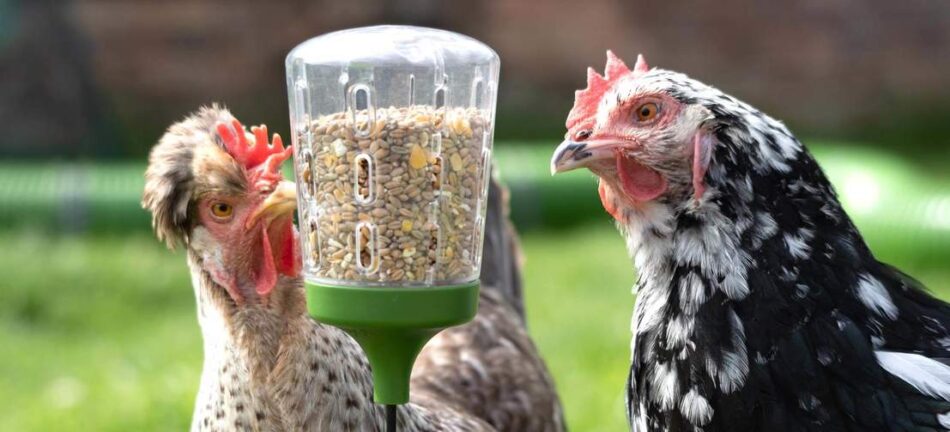
The very short answer to that question is probably no. If you give your chickens a good quality feed and some corn, and let them peck around the garden for insects and small stones they use to grind down their food they should technically be getting everything they need.
Any supplement should be given to your chickens as a complement to a healthy and balanced diet, and not instead of giving them good feed or sufficient space to live out natural chicken behaviours. However, just like you might boost your own system with some extra vitamins and minerals, there are some things that you can give your hens that will help them stay healthier and give them more energy.
Particularly useful at more challenging times, like around a moult or during a particularly tough cold snap, we’ve listed all the supplements you might want to have in your cupboard:
Grit
Chickens don’t have teeth, but use small rocks and stones to grind their food down. Most free range chickens gather grit naturally while exploring the garden, but if you for some reason have to contain your chickens to a smaller area than normal, or if their run is covered in snow, you might need to add grit to their diet.
Make sure to choose something that is chicken specific and will have the right composition and size of components.
Vinegar
Vinegar, normally Apple Cider Vinegar, is a great booster all year around. It aids digestion, keeps internal parasites at bay, and is mildly antiseptic. In the winter it’s also fantastic to use preventatively to keep respiratory infections away from your flock.
Choose an organic or unpasteurised vinegar that contains a substance called ‘the mother’. It’s a gel-like substance that grows naturally on the vinegar, and it’s the mother that contains the most powerful enzymes and minerals that make the vinegar so beneficial.
Vinegar can be added to the chickens’ drinking water, approximately 10ml per liter of water.
Garlic
As well as keeping vampires away, garlic has been used for its beneficial properties for centuries, and it’s a great addition to your chickens’ diet.
You can crush up a fresh clove or use garlic powder to add to the feed. It’s great for circulation, and can help with respiratory infections. It’s also said to help ensure a good appetite, so it’s ideal to give it to newly rescued hens that need a nutrient boost.
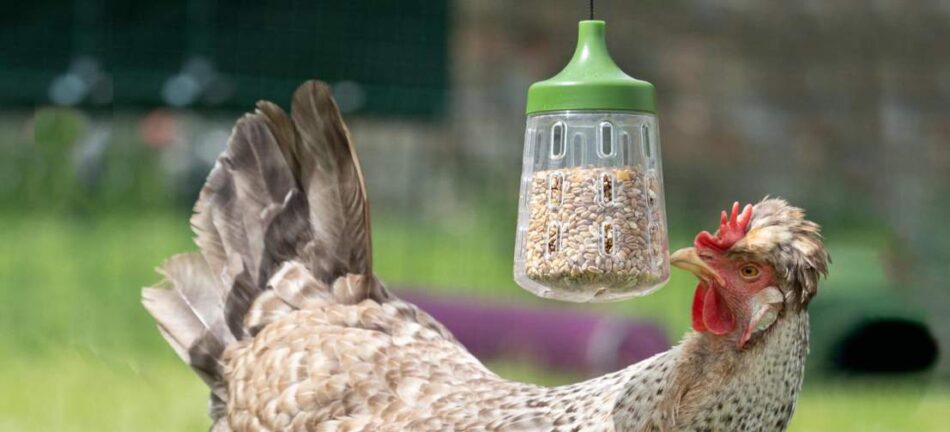
Herbs
Plenty of herbs and spices are said to have medicinal properties that will help your hens keep their immune system in top condition. Verm-X is a 100% natural supplement that helps maintain intestinal hygiene and keeps the hen’s gut and digestive system in great condition, which can help keep parasites and infections away.
Oregano, cinnamon, parsley, turmeric and ginger are other chicken favourites that will increase vitamin levels and aid the immune system, and that grinded down can be mixed into your chickens feed.
Calcium
Chickens use lots of calcium to build egg shells, so laying chickens can sometimes need a little more than they get from their pellets.
Equimins Egg Shell Improver is a great example of a supplement that contains high levels of calcium and phosphorus and will strengthen the quality of your chickens’ eggs. Ideal for ex battery hens or hens going through a moult.
Poultry Spice
This is a long term favourite with chicken keepers, a mineral supplement that will be beneficial to your chickens’ general health. It’s perfect for moulting, or to help maintain good appetite in winter.
This entry was posted in Chickens on October 5th, 2020 by linnearask
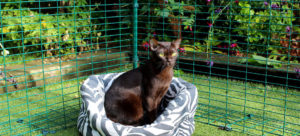
Cats that are let outside have a shorter life expectancy than indoor cats. Sure, some outdoor cats live until they’re 20 years old, but on average, letting your cat roam free outside significantly increases the risk of injuries, accidents, and infections.
There are clear pros and cons for both indoor and outdoor cat, but certain factors can encourage the decision to keep your beloved pets indoors most of the time.
Traffic
Cats and cars don’t mix, and if you live by a busy road you might not want to run the risk of letting your cat out to roam freely. Even the cleverest of cats can’t assess speed from a moving vehicle, and you’ll struggle to train them not to chase a mouse over the road without first checking the coast is clear.
Indoor breeds
Some cats are just not made to go outside. Their fur might not be thick enough to handle neither sun nor rain, they are not agile enough to move around different structures and textures, might not have the street smartness to stay out of trouble, or will just never see the point of outdoor activities, like exploring and hunting.
Cats with FIV
Feline Immunodeficiency Virus is a very contagious disease that significantly lowers your cat’s immune system. If your cat has been diagnosed with FIV, it’s highly recommended that you keep him or her indoors to stop them from passing the virus on, but also to protect them from infections or injuries that their immune system can’t handle.
Wildlife protection
Letting your cats roam free allows them to express natural behaviours, and one of these is the strong urge to hunt. While no one really cares about the odd mouse cats kill, people can get very upset when they see your cat bringing home song birds, baby hares or rare lizards. Wildlife fans are often great opponents of cat predation, and even if you trust your neighbours not to hurt your pet, letting your cat out might create an uncomfortable glitch between you and the rest of the neighbourhood.
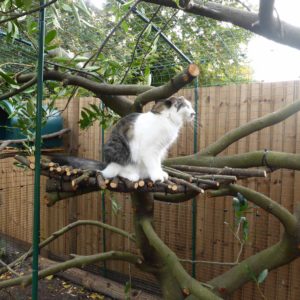 Cat thefts
Cat thefts
Cat thefts are more common than you might think, maybe not surprisingly seeing how much some popular cat breeds cost. Thieves might keep an eye on your cats comings and goings over a few days, and lure them away when no one will notice.
It’s important to be aware that this does happen, and if you have an expensive cat you might not want to let it run free outside without supervision.
Illness and injuries
If your cat is sick or has hurt themselves in some sort of accident, the vet might have told you to at least temporarily keep them indoors. While this can be extremely frustrating for both cat and owner, it’s important not to hurry the healing process by letting your cat out too early.
If any of these apply to you and your cat, or if you for some other reason have decided not to let your pets roam free, you’ll be glad to know that there is a great solution that will both give your pet access to fresh air (which is highly beneficial to both their physical and mental health) and keep them safe: a cat run.
The Omlet Outdoor Cat Run, or Balcony Cat Run, can be customised to fit the space you’ve got in your garden or on your balcony. It’s just over 2m high, so you can easily go inside to spend time with your cat in the run if you want, or you can leave them to play or rest in the sunshine while you tend to the garden.
The run can be placed on most surfaces, and you can decorate it with climbing toys and scratching posts to keep your cat active and entertained. It’s stable and secure, so you won’t have to worry about leaving your cat unsupervised for shorter periods of time.
Not having to walk your cat on a lead will mean he or she can be outside for longer, and by adding covers to your run you can make sure they won’t get rained on, or burn their skin in the sun.
In a cat run, your pet won’t get into contact with traffic or any other, potentially unfriendly cats. You will be able to limit and control how much he or she moves around to not over activate bones and muscles, and the risk of theft is greatly reduced. Not only will your cat be safer, small rodents and song birds can also live a slightly more relaxed life!
This entry was posted in Cats on October 2nd, 2020 by linnearask
 We often get questions about whether rabbits will be okay outside in the winter. The simple answer is: yes. But things get a little more complicated when you consider the specific climate, individual rabbits, and their setups. We’ll share how you can safely keep your outdoor rabbits outside during the winter, and how to determine if and when it’s time to bring them inside.
We often get questions about whether rabbits will be okay outside in the winter. The simple answer is: yes. But things get a little more complicated when you consider the specific climate, individual rabbits, and their setups. We’ll share how you can safely keep your outdoor rabbits outside during the winter, and how to determine if and when it’s time to bring them inside. 










 Most people would agree that the yolk is the best part of the egg. A double-yolker in the breakfast pan is therefore a very welcome sight!
Most people would agree that the yolk is the best part of the egg. A double-yolker in the breakfast pan is therefore a very welcome sight!






